Pitcairn Islands
| Pitcairn, Henderson, Ducie and Oeno Islands Pitkern Ailen (Pitcairnese) | |
|---|---|
.svg.png) Location of Pitcairn Islands (circled in red) in the Pacific Ocean (light blue) | |
| Status | British Overseas Territory |
| Capital |
Adamstown 25°04′S 130°06′W / 25.067°S 130.100°W |
| Languages | English, Pitcairnese |
| Ethnic groups | |
| Demonym | Pitcairn Islander[2] |
| Government | Dependency with a directly elected mayoralty under constitutional monarchy |
• Monarch | Elizabeth II |
• Governor | Laura Clarke |
| Nicola Hebb | |
• Mayor | Shawn Christian |
| Tariq Ahmad | |
| Legislature | Island Council |
| Area | |
• Total | 47 km2 (18 sq mi) |
| Population | |
• 2018 estimate | 50[3] (last) |
• 2010 census | 45 |
• Density | 1.19/km2 (3.1/sq mi) (240th) |
| GDP (nominal) | 2005 estimate |
• Total | NZ$ 217, 000[4] |
| Currency | New Zealand dollar[lower-alpha 2] (NZD) |
| Time zone | UTC–8 |
| Calling code | +64 |
| ISO 3166 code | PN |
| Internet TLD | .pn |
|
Website www | |
|
UK Postcode PCRN 1ZZ | |
The Pitcairn Islands (/ˈpɪtkɛərn/;[7] Pitkern: Pitkern Ailen), officially Pitcairn, Henderson, Ducie and Oeno Islands,[8][9][10][11] are a group of four volcanic islands in the southern Pacific Ocean that form the sole British Overseas Territory in the South Pacific. The four islands – Pitcairn proper, Henderson, Ducie, and Oeno – are scattered across several hundred miles of ocean and have a combined land area of about 47 square kilometres (18 sq mi). Henderson Island accounts for 86% of the land area, but only Pitcairn Island is inhabited.
Pitcairn is the least populous national jurisdiction in the world.[12] The Pitcairn Islanders are a biracial ethnic group descended mostly from nine Bounty mutineers and the handful of Tahitians who accompanied them, an event that has been retold in many books and films. This history is still apparent in the surnames of many of the islanders. Today there are only about 50 permanent inhabitants, originating from four main families.[13]
History
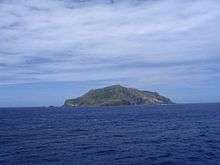
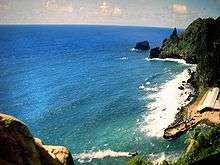
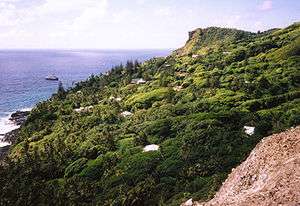
Polynesian settlement and extinction
The earliest known settlers of the Pitcairn Islands were Polynesians who appear to have lived on Pitcairn and Henderson, and on Mangareva Island 400 kilometres (250 mi) to the northwest, for several centuries. They traded goods and formed social ties among the three islands despite the long canoe voyages between them, which helped the small populations on each island survive despite their limited resources. Eventually, important natural resources were exhausted, inter-island trade broke down and a period of civil war began on Mangareva, causing the small human populations on Henderson and Pitcairn to be cut off and eventually become extinct.
Although archaeologists believe that Polynesians were living on Pitcairn as late as the 15th century, the islands were uninhabited when they were rediscovered by Europeans.[14]
European discovery
Ducie and Henderson Islands were discovered by Portuguese sailor Pedro Fernandes de Queirós, sailing for the Spanish Crown, who arrived on 26 January 1606. He named them La Encarnación ("The Incarnation") and San Juan Bautista ("Saint John the Baptist"), respectively. However, some sources express doubt about exactly which of the islands were visited and named by Queirós, suggesting that La Encarnación may actually have been Henderson Island, and San Juan Bautista may have been Pitcairn Island.[15]
Pitcairn Island was sighted on 3 July 1767 by the crew of the British sloop HMS Swallow, commanded by Captain Philip Carteret. The island was named after Midshipman Robert Pitcairn, a fifteen-year-old crew member who was the first to sight the island. Robert Pitcairn was a son of British Marine Major John Pitcairn, who later was killed at the 1775 Battle of Bunker Hill in the American Revolution.
Carteret, who sailed without the newly-invented marine chronometer, charted the island at 25°02′S 133°21′W / 25.033°S 133.350°W, and although the latitude was reasonably accurate, his recorded longitude was incorrect by about 3° (330 km, 210 mi) west of the island. This made Pitcairn difficult to find, as highlighted by the failure of Captain James Cook to locate the island in July 1773.[16][17]
European settlement

In 1790 nine of the mutineers from the Bounty, along with the native Tahitian men and women who were with them (6 men, 11 women, and a baby girl), settled on Pitcairn Islands and set fire to the Bounty. The wreck is still visible underwater in Bounty Bay, discovered in 1957 by National Geographic explorer Luis Marden. Although the settlers survived by farming and fishing, the initial period of settlement was marked by serious tensions among them. Alcoholism, murder, disease, and other ills took the lives of most mutineers and Tahitian men. John Adams and Ned Young turned to the scriptures, using the ship's Bible as their guide for a new and peaceful society. Young eventually died of an asthmatic infection.
Ducie Island was rediscovered in 1791 by Royal Navy Captain Edwards aboard HMS Pandora, while searching for the Bounty mutineers. He named it after Francis Reynolds-Moreton, 3rd Baron Ducie, also a captain in the Royal Navy.
The Pitcairn islanders reported it was not until 27 December 1795 that the first ship since the Bounty was seen from the island, but it did not approach the land and they could not make out the nationality. A second ship appeared in 1801, but made no attempt to communicate with them. A third came sufficiently near to see their house, but did not try to send a boat on shore. Finally, the American sealing ship Topaz under Mayhew Folger became the first to visit the island, when the crew spent 10 hours on Pitcairn in February 1808.
A report of Folger's discovery was forwarded to the Admiralty, mentioning the mutineers and giving a more precise location of the island: 25°02′S 130°00′W / 25.033°S 130.000°W.[18] However this was not known to Sir Thomas Staines, who commanded a Royal Navy flotilla of two ships (HMS Briton and HMS Tagus) which found the island at 25°04′S 130°25′W / 25.067°S 130.417°W (by meridian observation) on 17 September 1814. Staines sent a party ashore and wrote a detailed report for the Admiralty.[19][20][21][22] By that time, only one mutineer, John Adams, remained alive. He was granted amnesty for his part in the mutiny.[19]
Henderson Island was rediscovered on 17 January 1819 by British Captain James Henderson of the British East India Company ship Hercules. Captain Henry King, sailing on the Elizabeth, landed on 2 March to find the king's colours already flying. His crew scratched the name of their ship into a tree. Oeno Island was discovered on 26 January 1824 by American Captain George Worth aboard the whaler Oeno.
In 1832 a Church Missionary Society missionary, Joshua Hill, arrived; he reported that by March 1833 he had founded a Temperance Society to combat drunkenness, a “Maundy Thursday Society”, a monthly prayer meeting, a juvenile society, a Peace Society, and a school.[23]
British colony
Traditionally, Pitcairn Islanders consider that their islands "officially" became a British colony on 30 November 1838, at the same time becoming one of the first territories to extend voting rights to women. By the mid-1850s, the Pitcairn community was outgrowing the island; its leaders appealed to the British government for assistance, and were offered Norfolk Island. On 3 May 1856, the entire population of 193 people set sail for Norfolk on board the Morayshire, arriving on 8 June after a difficult five-week trip. However, just eighteen months later, seventeen of the Pitcairn Islanders returned to their home island, and another 27 followed five years later.[19]
HMS Thetis visited Pitcairn Island on 18 April 1881 and "found the people very happy and contented, and in perfect health." At that time the population was 96; an increase of six since the visit of Admiral de Horsey in September 1878. Stores had recently been delivered from friends in England, including two whale-boats and Portland cement, which was used to make the reservoir watertight. HMS Thetis gave the islanders 200 lb (91 kg) of biscuits, 100 lb (45 kg) of candles, and 100 lb (45 kg) of soap and clothing to the value of £31, donated by the ship's company. An American trading ship called Venus had recently bestowed a supply of cotton seed, to provide the islanders with a crop for future trade.[24]
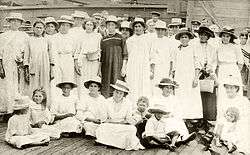
In 1886, the Seventh-day Adventist layman John Tay visited Pitcairn and persuaded most of the islanders to accept his faith. He returned in 1890 on the missionary schooner Pitcairn with an ordained minister to perform baptisms. Since then, the majority of Pitcairn Islanders have been Adventists.[25]
The islands of Henderson, Oeno and Ducie were annexed by Britain in 1902: Henderson on 1 July, Oeno on 10 July, and Ducie on 19 December.[26] In 1938, the three islands, along with Pitcairn, were incorporated into a single administrative unit called the "Pitcairn Group of Islands".
The population peaked at 233 in 1937;[27] it has since reduced owing to emigration, primarily to Australia and New Zealand.[2]
Sexual assault trials of 2004
In 2004, charges were laid against seven men living on Pitcairn and six living abroad. This accounted for nearly a third of the male population. After extensive trials, most of the men were convicted, some with multiple counts of sexual encounters with children.[28] On 25 October 2004, six men were convicted, including Steve Christian, the island's mayor at the time.[29][30][31] In 2004, the islanders had about 20 guns among them, which they surrendered ahead of the sexual assault trials.[32] After the six men lost their final appeal, the British government set up a prison on the island at Bob's Valley.[33][34] The men began serving their sentences in late 2006. By 2010, all had served their sentences or been granted home detention status.[35]
2010 and 2016 trials
In 2010, the then mayor Mike Warren faced 25 charges of possessing images and videos of child pornography on his computer.[36][37] In 2016 Warren was found guilty of downloading more than 1000 images and videos of child sexual abuse. Warren began downloading the images some time after the 2004 sexual assault convictions. During the time he downloaded the images he was working in child protection. Warren was also convicted of engaging in a "sex chat" with someone who he believed was a 15-year-old girl.[38]
Geography
The Pitcairn Islands form the southeasternmost extension of the geological archipelago of the Tuamotus of French Polynesia, and consist of four islands: Pitcairn Island, Oeno Island (atoll with five islets, one of which is Sandy Island), Henderson Island and Ducie Island (atoll with four islets).
The Pitcairn Islands were formed by a centre of upwelling magma called the Pitcairn hotspot.
The only permanently inhabited island, Pitcairn, is accessible only by boat through Bounty Bay. Henderson Island, covering about 86% of the territory's total land area and supporting a rich variety of animals in its nearly inaccessible interior, is also capable of supporting a small human population despite its scarce fresh water, but access is difficult, owing to its outer shores being steep limestone cliffs covered by sharp coral. In 1988, this island was designated as a UNESCO World Heritage site.[39] The other islands are at a distance of more than 100 km (62 mi) and are not habitable.
| Island or atoll | Type | Land area (km2) | Total area (km2) | Pop. July 2011 | Coordinates |
|---|---|---|---|---|---|
| Ducie Island | Atoll† | 0.7 | 3.9 | 0 | 24°40′09″S 124°47′11″W / 24.66917°S 124.78639°W |
| Henderson Island | Uplifted coral island | 37.3 | 37.3 | 0 | 24°22′01″S 128°18′57″W / 24.36694°S 128.31583°W |
| Oeno Island | Atoll† | 0.65 | 16.65 | 0 | 23°55′26″S 130°44′03″W / 23.92389°S 130.73417°W |
| Pitcairn Island | Volcanic island | 4.6 | 4.6 | 68 | 25°04′00″S 130°06′00″W / 25.06667°S 130.10000°W |
| Pitcairn Islands (all islands) | – | 43.25 | 62.45 | 68 | 23°55′26″ to 25°04′00″S, 124°47′11″ to 130°44′03″W |
† Includes reef flat and lagoon of the atolls.
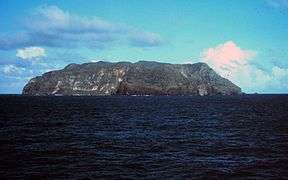 View from east side of Pitcairn Island
View from east side of Pitcairn Island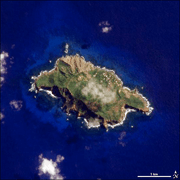 Satellite photo of Pitcairn Island
Satellite photo of Pitcairn Island Map of Pitcairn Islands
Map of Pitcairn Islands View of Bounty Bay
View of Bounty Bay
Climate
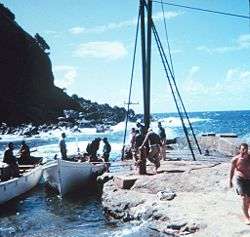
Pitcairn is located just south of the Tropic of Capricorn and experiences year-round warm weather, with wet summers and drier winters. The rainy season (summer) is from November through to March, when temperatures average 25 to 35 °C (77 to 95 °F) and humidity averages can exceed 95%. Temperatures in the winter range from 17 to 25 °C (63 to 77 °F).[2]
Flora
About nine plant species are thought to occur only on Pitcairn. These include tapau, formerly an important timber resource, and the giant nehe fern. Some, such as red berry (Coprosma rapensis var. Benefica), are perilously close to extinction.[40] The plant species Glochidion pitcairnense is endemic to Pitcairn and Henderson Islands.[41]
Fauna
Between 1937 and 1951, Irving Johnson, skipper of the 29-metre (96 ft) brigantine Yankee Five, introduced five Galápagos giant tortoises to Pitcairn. Turpen, also known as Mr. Turpen or Mr. T, is the sole survivor. Turpen usually lives at Tedside by Western Harbour. A protection order makes it an offence should anyone kill, injure, capture, maim, or cause harm or distress to the tortoise.[42]
The birds of Pitcairn fall into several groups. These include seabirds, wading birds and a small number of resident land-bird species. Of 20 breeding species, Henderson Island has 16, including the unique flightless Henderson crake; Oeno hosts 12; Ducie 13 and Pitcairn six species. Birds breeding on Pitcairn include the fairy tern, common noddy and red-tailed tropicbird. The Pitcairn reed warbler, known by Pitcairners as a "sparrow", is endemic to Pitcairn Island; formerly common, it was added to the endangered species list in 2008.[43]
A small population of humpback whales which has been poorly studied annually migrate to the islands to winter and breed.[44]
Important bird areas
The four islands in the Pitcairn group have been identified by BirdLife International as separate Important Bird Areas (IBAs). Pitcairn Island is recognised because it is the only nesting site of the Pitcairn reed warbler. Henderson Island is important for its endemic land-birds as well as its breeding seabirds. Oeno's ornithological significance derives principally from its Murphy's petrel colony. Ducie is important for its colonies of Murphy's, herald and Kermadec petrels, and Christmas shearwaters.[45]
Pitcairn Islands Marine Reserve
In March 2015 the British government established one of the largest marine protected areas in the world around the Pitcairn Islands. The reserve covers the islands' entire exclusive economic zone – 834,334 square kilometres (322,138 sq mi). The intention is to protect some of the world's most pristine ocean habitat from illegal fishing activities. A satellite "watchroom" dubbed Project Eyes on the Seas has been established by the Satellite Applications Catapult and the Pew Charitable Trusts at the Harwell Science and Innovation Campus in Harwell, Oxfordshire to monitor vessel activity and to gather the information needed to prosecute unauthorised trawling. [46][47][48][49]
Politics

The Pitcairn Islands are a British overseas territory with a degree of local government. The Queen of the United Kingdom is represented by a Governor, who also holds office as British High Commissioner to New Zealand and is based in Wellington.[50]
The 2010 constitution gives authority for the islands to operate as a representative democracy, with the United Kingdom retaining responsibility for matters such as defence and foreign affairs. The Governor and the Island Council may enact laws for the "peace, order and good government" of Pitcairn. The Island Council customarily appoints a Mayor of Pitcairn as a day-to-day head of the local administration. There is a Commissioner, appointed by the Governor, who liaises between the Council and the Governor's office.
Since 2015, same-sex marriage has been legal on Pitcairn Island, although there are no people on the island known to be in such a relationship.[51]
The Pitcairn Islands has the smallest population of any democracy in the world.
The United Nations Committee on Decolonization includes the Pitcairn Islands on the United Nations list of Non-Self-Governing Territories.[52]
Military
The Pitcairn Islands are an overseas territory of the United Kingdom; defence is the responsibility of the Ministry of Defence and Her Majesty's Armed Forces.[2]
Economy
Agriculture
The fertile soil of the Pitcairn valleys, such as Isaac's Valley on the gentle slopes southeast of Adamstown, produces a wide variety of fruits: including bananas (Pitkern: plun), papaya (paw paws), pineapples, mangoes, watermelons, cantaloupes, passionfruit, breadfruit, coconuts, avocadoes, and citrus (including mandarin oranges, grapefruit, lemons and limes). Vegetables include: sweet potatoes (kumura), carrots, sweet corn, tomatoes, taro, yams, peas, and beans. Arrowroot (Maranta arundinacea) and sugarcane are grown and harvested to produce arrowroot flour and molasses, respectively. Pitcairn Island is remarkably productive and its benign climate supports a wide range of tropical and temperate crops.[53] All land allocation for any use including agriculture is under the discretion of the government. If the government deems agricultural production excessive then it may tax the land. If the agricultural land has been deemed not up to the standards of the government it may confiscate and transfer the land without compensation.[54]
Fish are plentiful in the seas around Pitcairn. Spiny lobster and a large variety of fish are caught for meals and for trading aboard passing ships. Almost every day someone will go fishing, whether it is from the rocks, from a longboat or diving with a spear gun. There are numerous types of fish around the island. Fish such as nanwee, white fish, moi and opapa are caught in shallow water, while snapper, big eye and cod are caught in deep water, and yellow tail and wahoo are caught by trawling. A range of minerals—including manganese, iron, copper, gold, silver and zinc—have been discovered within the Exclusive Economic Zone, which extends 370 km (230 mi) offshore and comprises 880,000 km2 (340,000 sq mi).[55]
Honey production
In 1998 the UK's overseas aid agency, the Department for International Development, funded an apiculture programme for Pitcairn which included training for Pitcairn's beekeepers and a detailed analysis of Pitcairn's bees and honey with particular regard to the presence or absence of disease. Pitcairn has one of the best examples of disease-free bee populations anywhere in the world and the honey produced was and remains exceptionally high in quality. Pitcairn bees are also a placid variety and, within a short time, beekeepers are able to work with them wearing minimal protection.[56] As a result, Pitcairn exports honey to New Zealand and to the United Kingdom. In London, Fortnum & Mason sells it and it is a favourite of Queen Elizabeth and Prince Charles.[57] The Pitcairn Islanders, under the "Bounty Products" and "Delectable Bounty" brands, also export dried fruit including bananas, papayas, pineapples and mangoes to New Zealand.[58] Honey production and all honey related products are a protected monopoly.[59] All funds and management are under the supervision and discretion of the government.[60][61]
Cuisine
_Sunda.jpg)
Cuisine is not very developed, because only 50 people live on Pitcairn. The most traditional meal is pota, mash from palm leaves and coconut.[62] Tropical plants are abundantly used because they grow here. These include: basil, breadfruit, sugar cane, coconut, bananas and beans. Meat mainly uses fish and pork. A palm leaf is used in this cuisine. Because most of the population is from the UK, the cuisine is influenced by British cuisine, for example, the meat pie.[63]
The cuisine of Norfolk Island is very similar to that of the Pitcairn Islands, as Norfolk Islanders trace their origins to Pitcairn. The local cuisine is a blend of British cuisine and Tahitian cuisine.[64][65]
Recipes from Norfolk Island of Pitcairn origin include mudda (green banana dumplings) and kumara pilhi.[66][67] The islands cuisine also contains American influences not found in Pitcairn, such as chopped salads and fruit pies, due to the influences of American whalers.[68]
Tourism
Tourism plays a major role on Pitcairn. Tourism is the focus for building the economy. It focuses on small groups coming by charter vessel and staying at "home stays". About ten times a year, passengers from expedition-type cruise ships come ashore for a day, weather permitting.[69][70] Since 2009, the government has been operating the MV Claymore II as the island's only dedicated passenger/cargo vessel, providing adventure tourism holidays to Pitcairn for three-day or ten-day visits. Tourists stay with local families and experience the island's culture while contributing to the local economy. Providing accommodation is a growing source of revenue, and some families have invested in private self-contained units adjacent to their homes for tourists to rent.
Entry requirements for short stays, up to 14 days, which do not require a visa, and for longer stays, that do require prior clearance, are explained in official documents.[71][72] All persons under 16 years of age require prior clearance before landing, irrespective of the length of stay.[73]
Lesser revenue sources
The Pitcairners are involved in creating crafts and curios (made out of wood from Henderson). Typical woodcarvings include sharks, fish, whales, dolphins, turtles, vases, birds, walking sticks, book boxes, and models of the Bounty. Miro (Thespesia populnea), a dark and durable wood, is preferred for carving. Islanders also produce tapa cloth and painted Hattie leaves.[74] The major sources of revenue have been the sale of coins and postage stamps to collectors, .pn domain names, and the sale of handicrafts to passing ships, most of which are on the United Kingdom to New Zealand route via the Panama Canal.[75] The flow of funds from these revenue sources are from customer to the government to the Pitcairners.[61] The government holds a monopoly over "any article of whatsoever nature made, manufactured, prepared for sale or produced by any of the inhabitants of Pitcairn Island."[60]
Electricity
Diesel generators provide the island with electricity from 8 am to 1 pm, and from 5 pm to 10 pm. A wind power plant was planned to be installed to help reduce the high cost of power generation associated with the import of diesel, but was cancelled in 2013 after a project overrun of three years and a cost of £250,000.[76]
The only qualified high voltage electricity technician on Pitcairn, who manages the electricity grid, reached the age of 65 in 2014.[13]
Demographics
The islands have suffered a substantial population decline since 1940, and the viability of the island's community is in doubt (see § Potential extinction, below). The government has tried to attract migrants. However, these initiatives have not been effective.[77]
Only two children were born on Pitcairn in the 21 years prior to 2012.[78] In 2005, Shirley and Simon Young became the first married outsider couple in history to obtain citizenship on Pitcairn.[79]
Language
Most resident Pitcairn Islanders are descendants of the Bounty mutineers and Tahitians (or other Polynesians). Pitkern is a creole language derived from 18th-century English, with elements of the Tahitian language.[2][39] It is spoken as a first language by the population and is taught alongside English at the island's only school. It is closely related to the creole language Norfuk, spoken on Norfolk Island, because Norfolk was repopulated in the mid-19th century by Pitcairners.
Religion
The entire population is Seventh-day Adventist.[2] The Seventh-Day Adventist Church is not a state religion, as no laws concerning its establishment were passed by the local government. A successful Seventh-day Adventist mission in the 1890s was important in shaping Pitcairn society. In recent years, the church has declined, and as of 2000, eight of the then forty islanders attended services regularly,[80] but most attend church on special occasions. From Friday at sunset until Saturday at sunset, Pitcairners observe a day of rest in observance of the Sabbath, or as a mark of respect for observant Adventists.
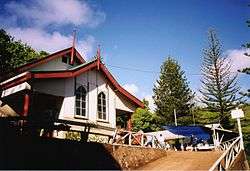
The church was built in 1954 and is run by the Church board and resident pastor, who usually serves a two-year term. The Sabbath School meets at 10 am on Saturday mornings, and is followed by Divine Service an hour later. On Tuesday evenings, there is another service in the form of a prayer meeting.
Education
Education is free and compulsory between the ages of five and sixteen. Children up to the age of 12 are taught at Pulau School, while children of 13 and over attend secondary school in New Zealand.[81]
The island's children have produced a book in Pitkern and English called Mi Bas Side orn Pitcairn or My Favourite Place on Pitcairn.
The school at Pitcairn, Pulau School, provides pre-school and primary education based on the New Zealand syllabus. The teacher is appointed by the governor from suitable qualified applicants who are registered teachers.
Historical population
Pitcairn's population has significantly decreased since its peak of over 200 in the 1930s, to only around fifty permanent residents today (2012–2018).[82][83]
| Year | Population | Year | Population | Year | Population | Year | Population | Year | Population | Year | Population |
|---|---|---|---|---|---|---|---|---|---|---|---|
| 1790 | 27 | 1880 | 112 | 1970 | 96 | 1992 | 54 | 2002 | 48 | 2012 | 48 |
| 1800 | 34 | 1890 | 136 | 1975 | 74 | 1993 | 57 | 2003 | 59 | 2013 | 56 |
| 1810 | 50 | 1900 | 136 | 1980 | 61 | 1994 | 54 | 2004 | 65 | 2014 | 56 |
| 1820 | 66 | 1910 | 140 | 1985 | 58 | 1995 | 55 | 2005 | 63 | 2015 | 50 |
| 1830 | 70 | 1920 | 163 | 1986 | 68 | 1996 | 43 | 2006 | 65 | 2016 | 49 |
| 1840 | 119 | 1930 | 190 | 1987 | 59 | 1997 | 40 | 2007 | 64 | 2017 | 50 |
| 1850 | 146 | 1936 | 250 | 1988 | 55 | 1998 | 66 | 2008 | 66 | 2018 | [lower-roman 1]50 |
| 1856 | [lower-roman 2]193 | 1940 | 163 | 1989 | 55 | 1999 | 46 | 2009 | 67 | ||
| 1859 | [lower-roman 3]16 | 1950 | 161 | 1990 | 59 | 2000 | 51 | 2010 | 64 | ||
| 1870 | 70 | 1960 | 126 | 1991 | 66 | 2001 | 44 | 2011 | 67 |
Potential extinction
As of July 2014, the total resident population of the Pitcairn Islands was 56, including the six temporary residents: an administrator, a doctor, a police officer, and their spouses.[84] However, the actual permanent resident population was only 49 Pitcairners spread across 23 households.[13] It is, however, rare for all 49 residents to be on-island at the same time; it is common for several residents to be off-island for varying lengths of time visiting family, for medical reasons, or to attend international conferences. As of November 2013 for instance, seven residents were off-island.[13] A diaspora survey projected that by 2045, if nothing were done, only three people of working age would be left on the island, with the rest being very old. In addition, the survey revealed that residents who had left the island over the past decades showed little interest in coming back. Of the hundreds of emigrants contacted, only 33 were willing to participate in the survey and just three expressed a desire to return.
As of 2014, the labour force consisted of 31 able-bodied persons: 17 males and 14 females between 18 and 64 years of age. Of the 31, just seven are younger than 40, but 18 are over the age of 50.[13] Most of the men undertake the more strenuous physical tasks on the island such as crewing the longboats, cargo handling, and the operation and maintenance of physical assets. Longboat crew retirement age is 58. There were then 12 men aged between 18 and 58 residing on Pitcairn. Each longboat requires a minimum crew of three; of the four longboat coxswains, two were in their late 50s.[13]
The Pitcairn government's attempts to attract migrants have been unsuccessful. Since 2013, some 700 make inquiries each year, but so far, not a single formal settlement application has been received.[13][77] The migrants are prohibited from taking local jobs or claiming benefits for a certain length of time, even those with children.[85] The migrants are expected to have at least NZ$ 30 000 per person in savings and are expected to build their own house at average cost of NZ$ 140 000.[86][87] It is also possible to bring off-island builders at an additional cost of between NZ$ 23 000 and NZ$ 28 000.[87] The average annual cost of living on the island is NZ$ 9464.[86] There is, however, no assurance of the migrant's right to remain on Pitcairn; after their first two years, the council must review and reapprove the migrant's status.[88] The migrants are also required to take part in the unpaid public work to keep the island in order: maintain the island's numerous roads and paths, build roads, navigate the island longboats, clean public toilets, etc.[89] There are also restrictions on bringing children under the age of 16 to the island.[36][90]
Freight from Tauranga to Pitcairn on the MV Claymore II (Pitcairn Island's dedicated passenger and cargo ship chartered by the Pitcairn government) is charged at NZ$ 350/m³ for Pitcairners and NZ$ 1000/m³ for all other freight.[91] Additionally, Pitcairners are charged NZ$ 3000 for a one-way trip; others are charged NZ$ 5000.[13]
In 2014, the government's Pitcairn Islands Economic Report stated that "[no one] will migrate to Pitcairn Islands for economic reasons as there are limited government jobs, a lack of private sector employment, as well as considerable competition for the tourism dollar". The Pitcairners take tourists in turns to accommodate those few tourists who occasionally visit the island.[13]
As the island remains a British Overseas Territory, at some point the British government may have to make a decision about the island's future.[92][93]
Culture
The once-strict moral codes, which prohibited dancing, public displays of affection, smoking, and consumption of alcohol, have been relaxed. Islanders and visitors no longer require a six-month licence to purchase, import, and consume alcohol.[94] There is now one licensed café and bar on the island, and the government store sells alcohol and cigarettes.
Fishing and swimming are two popular recreational activities. A birthday celebration or the arrival of a ship or yacht will involve the entire Pitcairn community in a public dinner in the Square, Adamstown. Tables are covered in a variety of foods, including fish, meat, chicken, pilhi, baked rice, boiled plun (banana), breadfruit, vegetable dishes, an assortment of pies, bread, breadsticks, an array of desserts, pineapple and watermelon.
Public work ensures the ongoing maintenance of the island's numerous roads and paths. As of 2011, the island had a labour force of over 35 men and women.[2]
Bounty Day is an annual public holiday celebrated on Pitcairn on 23 January[95] to commemorate the day in 1790 when the mutineers arrived on the island in HMS Bounty.
Media and communications
- The UK Postcode for directing mail to Pitcairn Island is PCRN 1ZZ.
- Telephones
Pitcairn uses New Zealand's international calling code, +64. It is still on the manual telephone system.
- Radio
- There is no broadcast station. Marine band walkie-talkie radios are used to maintain contact among people in different areas of the island. Foreign stations can be picked up on shortwave radio.
- Amateur radio
- Callsign website QRZ.COM lists six amateur radio operators on the island, using the ITU prefix (assigned through the UK) of VP6. However, some of those operators have died, while others are no longer active. The last DX-pedition to Pitcairn took place in 2012.[96] In 2008, a major DX-pedition visited Ducie Island.[97]
- Television
- Pitcairn can receive a number of television channels but only has capacity to broadcast two channels to houses at any one time. The channels are currently switched on a regular basis.[98]
- Internet
- There is one government-sponsored satellite internet connection, with networking provided to the inhabitants of the island. Pitcairn's country code top-level domain is .pn. Residents pay NZ$ 100 (about £50) for 2 GB of data per month, at a rate of 256 kbit/s.[99] In 2012, a single 1Mbit/s link installed provided the islanders with an internet connection, the 1Mbit/s was shared across all families on the island. By December 2017, the British Government implemented a 4G LTE mobile network in Adamstown with shared speeds of 5 Mbit/s across all islanders.[100]
Transport
All settlers of the Pitcairn Islands arrived by boat or ship. Pitcairn Island does not have an airport, airstrip or seaport; the islanders rely on longboats to ferry people and goods between visiting ships and shore through Bounty Bay.[69] Access to the rest of the shoreline is restricted by jagged rocks. The island has one shallow harbour with a launch ramp accessible only by small longboats.[101]
A dedicated passenger and cargo supply ship chartered by the Pitcairn Island government, the MV Claymore II, is the principal transport from Mangareva, Gambier Islands, French Polynesia; although passage can also be booked through Pitcairn Travel, Pitcairn's locally owned tour operators who charter the SV Xplore, owned by Stephen Wilkins, which also departs from Mangareva.
Totegegie Airport in Mangareva can be reached by air from the French Polynesian capital Papeete.[102]
There is one 6.4-kilometre (4 mi) paved road leading up from Bounty Bay through Adamstown.
The main modes of transport on Pitcairn Islands are by four-wheel drive quad bikes and on foot.[69] Much of the road and track network and some of the footpaths of Pitcairn Island are viewable on Google's Street View.[103][104]
Notable people
- Ned Young (c.1762–1800 in Pitcairn) mutineer from the famous HMS Bounty incident, and co-founder of the mutineers' Pitcairn Island settlement.
- William McCoy (c.1763–1798 in Pitcairn) a Scottish sailor and a mutineer on board HMS Bounty.
- Fletcher Christian (1764 – 1793 in Pitcairn) Master's mate on board HMS Bounty, died here at age 28.[105]
- Matthew Quintal (1766–1799 in Pitcairn) was a Cornish able seaman and mutineer aboard HMS Bounty
- John Adams (1767–1829 in Pitcairn) the last survivor of the HMS Bounty mutineers who settled on Pitcairn Island in January 1790, the year after the mutiny
- Thursday October Christian I (1790 – 1831) was the first son of Fletcher Christian
- George Adams (1804–1873) served as Chief Magistrate on Pitcairn in 1848
- Thursday October Christian II (1820 – 1911) was a Pitcairn Islands political leader. He was the grandson of Fletcher Christian and son of Thursday October Christian I
- Simon Young (1823-1893) served as Magistrate of the Pitcairn Islands in 1849
- Moses Young (1829–1909) served as magistrate of Pitcairn Island four times, between 1865 and 1881.
- James Russell McCoy (1845 – 1924) served as Magistrate of Pitcairn Island 7 times, between 1870 and 1904
- Benjamin Stanley Young (1851–1934) served as Magistrate of the Pitcairn Islands twice, from 1884 to 1885, and in 1892.
- Rosalind Amelia Young (1853–1924) an historian from Pitcairn Islands.
- William Alfred Young (1863–1911) served as President of the Council, and Magistrate of Pitcairn Island three times, between 1897 and 1908.
- Matthew Edmond McCoy (1868 - 1929) served as Magistrate of Pitcairn Island in 1909.
- Gerard Bromley Robert Christian (1870 - 1919) served as Magistrate of Pitcairn Island from 1910 to 1919
- Edgar Allen Christian (1879 – 1960) a politician from Pitcairn and Chief Magistrate of Pitcairn Island on several occasions between 1923 and 1939
- Charles Richard Parkin Christian (1883 - 1971) a long-serving politician from Pitcairn and Chief Magistrate of Pitcairn Island for eleven years at various times between 1920 and 1957
- Frederick Martin Christian (1883 – 1971) a politician from Pitcairn and Chief Magistrate of Pitcairn Island on three occasions between 1921 and 1943
- John Lorenzo Christian (1895 - 1984) served as Chief Magistrate of Pitcairn Island, twice in 1952-54 and 1961–66
- Ivan Christian (1919 – 1991) a politician from Pitcairn and Chief Magistrate of Pitcairn Island from 1976 to 1984
- Brenda Christian (born 1953) a political figure from the Pitcairn Islands and served the territory as its first female Mayor from 8 November to 15 December 2004
Gallery
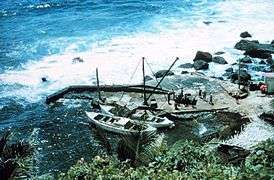 Bounty Bay in the 1970s
Bounty Bay in the 1970s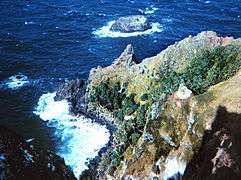 Pitcairn Island
Pitcairn Island- Henderson Island shelter
 Oeno
Oeno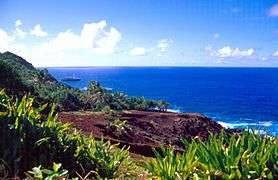 St. Paul's Point in west Pitcairn Island
St. Paul's Point in west Pitcairn Island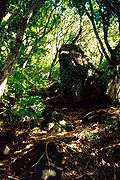 Garnets Ridge, Pitcairn Island
Garnets Ridge, Pitcairn Island
See also
- Bibliography of the Pitcairn Islands
- Bounty Bible
- Bounty Day
- Descendants of the Bounty mutineers
- Island Council (Pitcairn)
- Languages of the Pitcairn Islands
- Law enforcement in the Pitcairn Islands
- Lists of islands
- Mutiny on the Bounty
- Outline of the Pitcairn Islands
- Pitcairn Islanders
- Thursday October Christian I
Notes
- ↑ Minister of State in the Foreign and Commonwealth Office with responsibility for the British Overseas Territories.
- ↑ The Pitcairn Islands dollar is treated as a collectible/souvenir currency outside Pitcairn (non-circulating legal tender). U.S. dollar also widely accepted due to cruise ships.[5] Pound sterling also accepted.[6]
References
- 1 2 "Pitcairn Islands". nationalanthems.info. Retrieved 15 August 2018.
- 1 2 3 4 5 6 7 "CIA World Factbook: Pitcairn Islands". The World Factbook. Central Intelligence Agency. Retrieved 26 February 2013.
- 1 2 "Pitcairn Islands Tourism | Come Explore... The Legendary Pitcairn Islands". Visitpitcairn.pn. Retrieved 2018-01-03.
- ↑ "Pitcairn Islands Strategic Development Plan, 2012–2016" (PDF). The Government of the Pitcairn Islands. 2013. p. 4. Archived from the original (PDF) on 5 July 2015.
Gross Domestic Product (GDP) . . . NZ$ 217,000 (2005/06 indicative estimate) and NZ$ 4,340 per capita (based on 50 residents)
- ↑ "demtullpitcairn.com" (PDF). demtullpitcairn.com. Archived from the original (PDF) on 9 May 2016. Retrieved 3 January 2018.
- ↑ Asia and Pacific Review 2003/04 p.245 ISBN 1862170398
- ↑ Oxford English Dictionary
- ↑ "British Nationality Act 1981 – SCHEDULE 6 British Overseas Territories". UK Government. September 2016.
- ↑ "Pitcairn Constitution Order 2010 – Section 2 and Schedule 1, Section 6" (PDF). UK Government. September 2016.
- ↑ "Laws of Pitcairn, Henderson, Ducie and Oeno Islands". Pitcairn Island Council. September 2016.
- ↑ "The Overseas Territories" (PDF). UK Government. September 2016.
- ↑ Country Comparison: Population. The World Factbook.
- 1 2 3 4 5 6 7 8 9 Rob Solomon and Kirsty Burnett (January 2014) Pitcairn Island Economic Review. government.pn.
- ↑ Diamond, Jared M (2005). Collapse: how societies choose to fail or succeed. New York: Penguin. p. 132. ISBN 9780143036555. OCLC 62868295.
But by A.D. 1606 . . . Henderson's population had ceased to exist. Pitcairn's own population had disappeared at least by 1790 . . . and probably disappeared much earlier.
- ↑ "History of Government and Laws, Part 15 History of Pitcairn Island". Pitcairn Islands Study Centre. Archived from the original on 11 December 2014. Retrieved 4 July 2015.
- ↑ Brian Hooker. "Down with Bligh: hurrah for Tahiti". Finding New Zealand. Archived from the original on 26 May 2010. Retrieved 4 July 2015.
- ↑ Winthrop, Mark. "The Story of the Bounty Chronometer". Lareau Web Parlour. Archived from the original on 5 September 2009. Retrieved 4 July 2015.
- ↑ "Mutineers of the Bounty". The European Magazine, and London Review. Vol. 69. Philological Society of London. January–June 1816. p. 134.
- 1 2 3 "Pitcairn's History". The Government of the Pitcairn Islands. Archived from the original on 17 December 2014. Retrieved 4 July 2015.
- ↑ Chapter X Sir Thomas Staines. The Annual Biography and Obituary for the Year . . . 15. Longman, Hurst, Rees, Orme, and Brown. 1831. pp. 366–367.
- ↑ "History of Pitcairn Island". Pitcairn Islands Study Centre. Retrieved 15 September 2008.
- ↑ "Pitcairn descendants of the Bounty Mutineers". Jane's Oceania. 29 April 2009. Archived from the original on 14 August 2015.
- ↑ Church Missionary Society Archives. University of Birmingham. G/AC/15/75. quoted in Wolffe, John (2007). The age of Wilberforce, More, Chalmers, and Finney. The expansion of evangelicalism. 2. Inter-Varsity Press.
- ↑ "Visit To Pitcairn Island". The Cornishman (OCR text). 2 March 1882. p. 6.
- ↑ IBP USA (1 August 2013). Pitcairn Islands Business Law Handbook. International Business Publications. p. 92. ISBN 9781438770796. Retrieved 25 January 2015.
- ↑ Ben Cahoon. "Pitcairn Island". worldstatesmen.org. Retrieved 4 July 2010.
- ↑ "The People of Pitcairn Island". www.immigration.gov.pn. Retrieved 10 August 2018.
- ↑ Tweedie, Neil (5 October 2004). "Islander changes his plea to admit sex assaults". The Telegraph. London. Retrieved 29 November 2011.
- ↑ Fickling, David (25 October 2004). "Six found guilty in Pitcairn sex offences trial: Defendants claim British law does not apply". The Guardian. London. Archived from the original on 2 July 2015.
- ↑ "Six guilty in Pitcairn sex trial". BBC News. 25 October 2004. Retrieved 29 November 2011.
- ↑ "6 men convicted in Pitcairn trials". The New York Times. 24 October 2004. Retrieved 29 November 2011.
- ↑ "Pitcairn islanders to surrender guns". Television New Zealand. Reuters. 11 August 2004. Archived from the original on 17 March 2015. Retrieved 4 July 2015.
- ↑ Marks, Kathy (25 May 2005). "Pitcairners stay free till British hearing". The New Zealand Herald. Retrieved 29 November 2011.
- ↑ Marks, Kathy (2009). Lost Paradise: From Mutiny on the Bounty to a Modern-Day Legacy of Sexual Mayhem, the Dark Secrets of Pitcairn Island Revealed. Simon and Schuster. p. 288. ISBN 9781416597841.
- ↑ "Last Pitcairn rape prisoner released". The Sydney Morning Herald. 23 April 2009. Archived from the original on 2 July 2015. Retrieved 4 July 2015.
- 1 2 Gay, Edward (11 March 2013). "Pitcairn Island mayor faces porn charges in court". The New Zealand Herald.
- ↑ R v Michael Warren (Court of Appeal of the Pitcairn Islands 2012). Text
- ↑ Roy, Eleanor Ainge (7 March 2016). "Former Pitcairn mayor found guilty over child abuse images". Retrieved 17 November 2017 – via www.theguardian.com.
- 1 2 Editors of Encyclopædia Britannica, The (2015). "Pitcairn Island: Island, Pacific Ocean". Encyclopædia Britannica.
- ↑ S. Waldren and N. Kingston (1998). Coprosma rapensis var. benefica. IUCN Red List of Threatened Species.
- ↑ S. Waldren and N. Kingston (1998). Glochidion pitcairnense. IUCN Red List of Threatened Species.
- ↑ Endangered Species Protection Ordinance, 2004 revised edition. government.pn
- ↑ BirdLife International (2014). Acrocephalus vaughani. The IUCN Red List of Threatened Species.
- ↑ Catharine Horswill (a1) and Jennifer A. Jackson (a1). "Humpback whales wintering at Pitcairn Island, South Pacific". Cambridge.org. doi:10.1017/S1755267212000693. Retrieved 2018-01-03.
- ↑ BirdLife International. (2012). Important Bird Areas factsheet: Pitcairn Island.
- ↑ Gauke, David, ed. (2015). "2.259 Marine Protected Area (MPA) at Pitcairn" (PDF). Budget 2015: The Red Book (PDF). London: HM Treasury. p. 97. ISBN 978-1-4741-1616-9. OCLC 907644530. Archived (PDF) from the original on 10 October 2015.
The government intends to proceed with designation of [an] MPA around Pitcairn. This will be dependent upon reaching agreement with NGOs on satellite monitoring and with authorities in relevant ports to prevent landing of illegal catch, as well as on identifying a practical naval method of enforcing the MPA at a cost that can be accommodated within existing departmental expenditure limits.
- ↑ Amos, Jonathan (18 March 2015). "Budget 2015: Pitcairn Islands get huge marine reserve". BBC News. Retrieved 18 March 2015.
- ↑ "Pew, National Geographic Applaud Creation of Pitcairn Islands Marine Reserve" (Press release). London: The Pew Charitable Trusts. 18 March 2015. Retrieved 18 March 2015.
- ↑ Clark Howard, Brian (18 March 2015). "World's Largest Single Marine Reserve Created in Pacific". National Geographic. Retrieved 18 March 2015.
- ↑ "Home." Government of the Pitcairn Islands. Retrieved 31 October 2011.
- ↑ Press, Associated (22 June 2015). "Pitcairn Island, population 48, passes law to allow same-sex marriage".
- ↑ "United Nations list of Non-Self-Governing Territories". United Nations. Retrieved 4 July 2015.
- ↑ Secretariat of the Pacific Community (SPC): Pitcairn Islands-Joint Country Strategy, 2008.
- ↑ http://www.pitcairn.pn/Laws/Land%20Tenure%20Reform%20Ordinance.pdf
- ↑ Commonwealth Secretariat; Rupert Jones-Parry (2010). "Pitcairn Economy". The Commonwealth Yearbook 2010. Commonwealth Secretariat. ISBN 9780956306012.
- ↑ Laing, Aislinn (9 January 2010). "Sales of honey fall for the first time in six years amid British bee colony collapse". The Daily Telegraph. London. Retrieved 3 January 2015.
- ↑ Carmichael, Sri (8 January 2010). "I'll let you off, Mr Christian: you make honey fit for a queen". London Evening Standard. Retrieved 3 January 2015.
- ↑ Pitcairn Islands Study Center, News Release: Products from Pitcairn, 7 November 1999.
- ↑ http://www.pitcairn.pn/Laws/Apiaries%20Ordinance.pdf
- 1 2 http://www.pitcairn.pn/Laws/Pitcairn%20Souvenir%20Agency%20Ordinance.pdf
- 1 2 http://www.government.pn/Pitcairn%20Islands%20Economic%20Report%20-%20Final%20Report.pdf
- ↑ Zdroj: http://www.young.pn/dbz_potta.html
- ↑ Zdroj: http://ndish.com/pie/
- ↑ "Jasons". Jasons.
- ↑ "Norfolk Island Travel Guide - Norfolk Island Tourism - Flight Centre".
- ↑ "The Food of Norfolk Island". www.theoldfoodie.com.
- ↑ "Norfolk Island (Norfolk Island Recipes)". www.healthy-life.narod.ru.
- ↑ "Homegrown: Norfolk Island".
- 1 2 3 Foreign travel advice: Pitcairn. Foreign and Commonwealth Office. (6 December 2012). Retrieved 29 August 2016.
- ↑ Pitcairn Island Report prepared by Jaques and Associates, 2003, p. 21.
- ↑ "APPLYING FOR A VISA FOR PITCAIRN". The Government of the PITCAIRN ISLANDS. Pitcairn Islands Office. 30 March 2018. Retrieved 30 March 2018.
- ↑ "Immigration Control Ordinance" (PDF). p. 5. Retrieved 30 March 2018.
- ↑ "Entry requirements". Foreign travel advice Pitcairn Island. GOV>UK. 30 March 2018. Retrieved 30 March 2018.
- ↑ Foreign and Commonwealth Office, Profile on Pitcairn Islands, British Overseas Territory, 11 February 2010.
- ↑ Pitcairn Island Report prepared by Jaques and Associates, 2003, p. 18.
- ↑ "UK aid wasted on South Pacific windfarm fiasco: failed green energy scheme for only 55 people cost £250,000". Daily Mail. 8 April 2013. Retrieved 4 July 2015.
- 1 2 "Pitcairn Island, an idyll haunted by its past". Toronto Star. 16 December 2013.
- ↑ Ford, Herbert, ed. (30 March 2007). "News Releases: Pitcairn Island Enjoying Newest Edition [sic]". Pitcairn Islands Study Center. Angwin, California: Pacific Union College. Archived from the original on 12 October 2008.
- ↑ Pitcairn Miscellany, March 2005.
- ↑ "Turning Point for Historic Adventist Community on Pitcairn Island". Adventist News Network. Silver Spring, Maryland: General Conference of Seventh-day Adventists. 28 May 2001. Archived from the original on 19 October 2015.
Although the Adventist Church has always maintained a resident minister and nurse on Pitcairn, there have been fewer adherents and some church members have moved away from the island. By the end of 2000, regular church attendees among the island population of 40 numbered only eight.
- ↑ http://www.pitcairn.gov.pn/policies/SDP%202014-2018%20-%20Amended%2011-05-2016.pdf
- ↑ "Pitcairn Census". Pitcairn Islands Study Center. Retrieved 4 July 2015.
- ↑ "Pitcairn Islands Government online portal". www.government.pn. Retrieved 10 August 2018.
- ↑ "Pitcairn Residents". puc.edu.
- ↑ "Ch. XXII. Social Welfare Benefits Ordinance" in Laws of Pitcairn, Henderson, Ducie and Oeno Islands. Revised Edition 2014
- 1 2 Bill Haigh. "Pitcairn Island Immigration". immigration.pn
- 1 2 Kerry Young, Heather Menzies. "Pitcairn Island Immigration Questions and Answers". young.pn
- ↑ Ch. XII. "Immigration Control Ordinance" in Laws of Pitcairn, Henderson, Ducie and Oeno Islands. Revised Edition 2014
- ↑ Pitcairn Islands Repopulation Plan 2014–2019 Archived 3 December 2014 at the Wayback Machine.. The Pitcairn Islands Council
- ↑ "Pitcairn Island travel advice". gov.uk. UK government. Retrieved 6 September 2015.
- ↑ "Pitcairn Island Tourism: MV Claymore II Ship Info" Archived 15 February 2015 at Archive.is. visitpitcairn.pn
- ↑ "Pitcairn Islands Face Extinction". The Wall Street Journal. Retrieved 3 December 2014.
- ↑ "South Pacific Island of 'Mutiny on the Bounty' Fame Running Out of People". The Wall Street Journal. Retrieved 3 December 2014.
- ↑ Pitcairn Island Government Ordinance. government.pn; Archive.org
- ↑ "Pitcairn Islands – Bounty Day". www.flaginstitute.org. Retrieved 10 August 2018.
- ↑ "VP6T: Pitcairn". g3txf.com.
- ↑ VP6DX: Ducie Island. Ducie2008.dl1mgb.com. Retrieved 20 September 2013.
- ↑ Haigh, Bill. "Pitcairn Island Immigration". www.immigration.pn. Retrieved 2018-07-26.
- ↑ Slivka, Eric, "iPad Makes Its Way to the Farthest Reaches of the Earth" MacRumors.com. Retrieved 3 November 2010
- ↑ "Already Booked". Pitcairn Islands Tourism. Retrieved 22 June 2018.
- ↑ David H. Evans (2007) Pitkern Ilan = Pitcairn Island. Self-published, Auckland, p. 46
- ↑ Lonely Planet South Pacific, 3rd ed. 2006, "Pitcairn Getting There" pp. 429–430
- ↑ "Pitcairn News", 13 December 2013. Retrieved 13 February 2014
- ↑ "View from the end of St Pauls Point on Street View". Retrieved 13 February 2014
- ↑ Kirk, Robert W. (2012). "A White Tribe at Botany Bay, 1788–1911". Paradise Past: The Transformation of the South Pacific, 1520–1920. Jefferson, North Carolina: McFarland & Company. p. 61. ISBN 978-0-7864-6978-9. LCCN 2012034746. OCLC 791643077.
Further reading
Mutiny on the Bounty
- Mutiny on the Bounty by Charles Nordhoff and James Norman Hall, 1932
- The Bounty: The True Story of the Mutiny on the Bounty by Caroline Alexander (Harper Perennial, London, 2003 pp. 491)
- The Discovery of Fletcher Christian: A Travel Book by Glynn Christian, a descendant of Fletcher Christian, Bounty Mutineer (Guild Press, London, 2005 pp. 448)
After the Mutiny
- Men Against the Sea by Charles Nordhoff and James Norman Hall, 1933
- Pitcairn's Island by Charles Nordhoff and James Norman Hall, 1934
- The Pitcairners by Robert B. Nicolson (Pasifika Press, Auckland, 1997 pp. 260)
- After the Bounty: The Aftermath of the Infamous Mutiny on the HMS Bounty—An Insight to the Plight of the Mutineers by Cal Adams, a descendant of John Adams, Bounty Mutineer (Self-published, Sydney, 2008 pp. 184)
- The "Re-colonising of Pitcairn by Sue Farran, Senior Lecturer, University of Dundee; Visiting Lecturer, University of the South Pacific.
External links

Government
Travel
- Pitcairn Island Tourism Official tourism site of the Pitcairn Islands.
- Google Street View June 2013

Local news
- Pitcairn News from Big Flower News from Big Flower, Pitcairn Island.
- Pitcairn Miscellany News from Pitcairn Island. Jacqui Christian, ed.
- Pitcairn News information from Chris Double, a Bounty descendant based in Auckland
- Uklun Tul Un Dem Tul Pitcairn news by Kari Young, a Pitcairn resident.
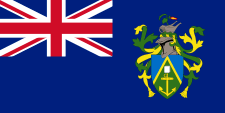
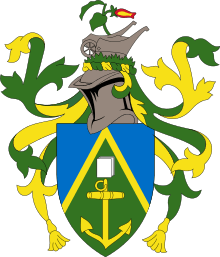
.svg.png)
